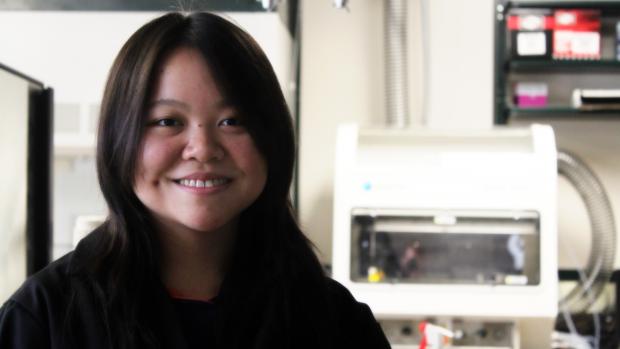Decoding the Secrets of Stem Cells
NYU-Poly junior conducts research at Auburn University and pursues a passion

When Yangzi (Isabel) Tian talks about stem cell research, her eyes light up and her hands move quickly through the air. Her energy is barely contained as she sits at the edge of her seat, a wide smile on her face.
To Tian, stem cell research isn’t an interest; it’s a passion, and she’s already building a reputation in the field though she’s just in her junior year at NYU-Poly.
Tian earned one of 10 spots in a prestigious internship this summer as part of the NSF Research Experience for Undergraduates Program in Micro/Nano-Structured Materials, Therapeutics and Devices at Auburn University.
During the 10-week program, in addition to conducting research under the mentorship of a professor and student researcher, Tian was required to create a poster describing the research she'd taken part in at the program. She presented the poster to a group of judges, including professors and industry professionals who were not affiliated with the students, at the conclusion of her internship and won first place. A couple of months later in mid-October, she went on to present her research again at the annual meeting of the Biomolecular Engineering Society.
“I think it was just my energy,” she said of how she achieved her first-place win. “If you ask my friends, anytime I talk about stem cells my eyes sparkle. Even after 10 weeks I was still so fascinated. I miss my stem cells!”
At Auburn, Tian studied under Dr. Elizabeth Lipke, the principal investigator of the Cardiovascular Tissue Engineering Lab. Lipke said she wasn’t surprised at all that Tian earned the top honor.
“I think she was the absolute best no matter what, but it’s like trying to ask a parent about her child,” Lipke said. “The judges really thought that she was the overall, all-around best.”
A Budding Interest
Tian became interested in stem cell research around 2008 and 2009, as word spread about the cells’ potential for curing disease. She was contemplating her future career path, and while she enjoyed biology and chemistry, she didn’t want to become a doctor.
“I wanted to contribute and make changes, but I needed variety; I wanted to create something new to impact a wider audience,” she said. “But it was my mom who really got me [interested] in this research.”
When Tian was a freshman in college, her mother was diagnosed with colon cancer. She watched her mother go through an intense surgery and then undergo chemotherapy treatments, which hurt her mother’s body while fighting the cancer.
“I hated the idea of putting a poison into the body to kill a disease,” Tian said. Her mother made a complete recovery, but the incident had a lasting effect on how Tian perceived disease and the potential to cure it without using techniques that often cause as much pain as the illness itself.
It was this interest that eventually inspired her to start researching opportunities to further her knowledge in the field, and which led her to the internship at Auburn. The program included a roster of speakers, mentoring in how to apply to grad school, plus research in the students’ areas of interest.
To the Labs
Heart disease is the number one cause of death for men and women in the United States. The ultimate goal of the research Tian was part of this summer is to improve our ability to repair the damaged or diseased heart, decrease the number of patients who need transplants and give those who are not eligible for transplants the chance for a better quality and possibly a longer life.
When Tian first began her studies in the lab, she was a novice, but with the help of Lipke and a student mentor, Aaron Seeto, she quickly caught on.
Seeto was studying rolling, adhesion and migration of endothelial progenitor cells, which are cells that come from the bone marrow and circulate in the blood.
In a healthy blood vessel, a single layer of endothelial cells lines the wall of the vessel. Promoting formation of this endothelial cell lining following the placement of devices, such as vascular grafts and stents, improves the long-term viability of these devices and reduces complications. Endothelial progenitor cells are a promising cell source for these applications. The lab is investigating cell-material interactions required for endothelial progenitor cells to populate surfaces in the blood stream; this knowledge could be used in the design of materials for next generation vascular grafts and stent coatings.
What Lies Ahead
Tian has come a long way since she first moved to the United States from China years ago. As a young girl, Tian originally thought she might study art, and her mother specifically chose Los Angeles as their new home because she wanted to encourage her daughter’s budding creativity.
Now as she considers her future, Tian’s envisioning ways to combine her love of art and science. She hopes to found a non-profit organization to teach people about stem cells through entertainment media, such as 3-D animation. It’s about business, art and science coming together.
Lipke said she believes Tian will make a tremendous difference, no matter what she chooses to specialize in.
“I’m just very interested to watch and see what Isabel does in this field because I think it will be incredible,” she said. “Isabel has a certain energy about her that sets her apart from other people in general—a great enthusiasm for life overall.”




